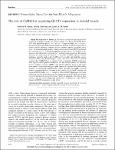The role of CaMKII in regulating GLUT4 expression in skeletal muscle

View/
Date
2012Author
Ojuka,Edward O.
Goyaram, Veeraj
Smith, James A. H.
Metadata
Show full item recordAbstract
The role of CaMKII in regulating GLUT4
expression in skeletal muscle. Am J Physiol Endocrinol Metab 303: E322–E331,
2012. First published April 10, 2012; doi:10.1152/ajpendo.00091.2012.—Contractile
activity during physical exercise induces an increase in GLUT4 expression in
skeletal muscle, helping to improve glucose transport capacity and insulin sensitivity.
An important mechanism by which exercise upregulates GLUT4 is through
the activation of Ca2 /calmodulin-dependent protein kinase II (CaMKII) in response
to elevated levels of cytosolic Ca2 during muscle contraction. This review
discusses the mechanism by which Ca2 activates CaMKII, explains research
techniques currently used to alter CaMK activity in cells, and highlights various
exercise models and pharmacological agents that have been used to provide
evidence that CaMKII plays an important role in regulating GLUT4 expression.
With regard to transcriptional mechanisms, the key research studies that identified
myocyte enhancer factor 2 (MEF2) and GLUT4 enhancer factor as the major
transcription factors regulating glut4 gene expression, together with their binding
domains, are underlined. Experimental evidence showing that CaMK activation
induces hyperacetylation of histones in the vicinity of the MEF2 domain and
increases MEF2 binding to its cis element to influence MEF2-dependent Glut4 gene
expression are also given along with data suggesting that p300 might be involved
in acetylating histones on the Glut4 gene. Finally, an appraisal of the roles of other
calcium- and non-calcium-dependent mechanisms, including the major HDAC
kinases in GLUT4 expression, is also given.
calcium/calmodulin-dependent protein kinase II; glucose transporter 4; myocyte
enhancer factor 2; histone hyperacetylation; histone deacetylase kinases
